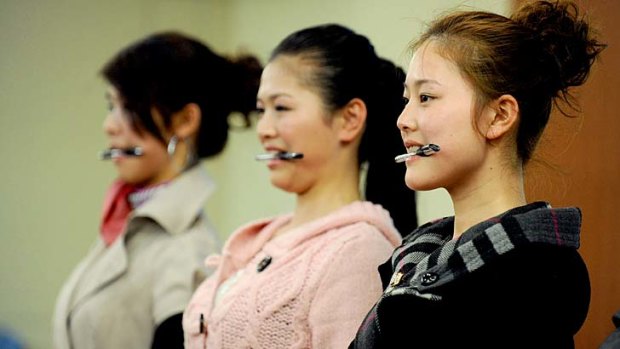
A group of young Chinese women practice standing and smiling properly during final selection to become flight attendants. Low-cost airlines are booming across the Asia-Pacific, but not in China.Credit: AFP
After a slow start, low-cost carriers (LCCs) are all the rage in the Asia-Pacific. Australia got its first taste of budget flying in the early 1990s with the emergence of the two Compasses, but much less liberal restrictions on aviation in Asia kept a lid on it there until after the turn of the century.
Virgin kicked off the resurgence of LCC flying in Australia a year before Tony Fernandes took over a heavily indebted government airline in Malaysia in 2001 and turned it into Asia’s biggest LCC, AirAsia.
Now almost everyone is in on the act: Qantas’ Jetstar subsidiary, Singapore’s Tiger Airways and now finally the Singapore Airlines long-haul offshoot Scoot Airlines. Jetstar will soon start a Hong Kong-based LCC in a joint venture with state-owned China Eastern Airlines.
But there’s one big black hole in the Asian flying boom where the government has simply said ‘no’ to the proliferation of LCCs: mainland China.
The country of 1.3 billion people – including tens of millions of middle-class flyers who are filling planes to all corners of the world – has a centrally planned communist economy where airlines are heavily restricted in what they can do, and have to get government permission for everything from the fares they charge, the domestic routes they can fly and the planes they buy.
China has just one LCC, Spring Airlines, based in the business capital, Shanghai.
According to Associated Press, the government regulator, the Civil Aviation Authority of China (CAAC), hinted in July that it would support budget airlines by loosening price controls. But CAAC director Li Jiaxiang stopped short of announcing any major policy reforms.
Analysts told AP the CAAC clamped down on airlines following a spell of supercharged growth during which the number of passengers expanded by 40 per cent in 2003-2004.
At about that time, China was also suffering an upsurge in air accidents. Such growth was putting strain on the training of pilots, who are now in short supply, and infrastructure such as air traffic control and airports, especially on heavily congested air routes between major Chinese cities including the big three, Beijing, Shanghai and Guangzhou.
“The market is already growing at 11-16 per cent domestically at average fares,” said Mario Hardy, of research firm UBM Aviation. “Imagine if an AirAsia or a Spring was able tomorrow to lower that price by half. How many more people would be travelling?”
But the government doesn’t want unfettered growth putting pressure on the airline business. The national government is in the process of building 82 new airports and renovating 101 others in a five-year plan that runs until 2015.
Even some analysts say a lid must be kept on growth. “Otherwise it will be a mess,” UBM’s Hardy said. “It would be chaos.”
In the meantime, the Chinese themselves complain about the fact that the Chinese state-owned airlines they’re forced to use on some routes are anything but cheap.
Businesswoman and travel blogger Ren Hong, who spoke to AP’s Kelvin Chan in Hong Kong, wants to go to India on her next trip but says there are limited options. She could fly with Air China at a cost of 4000-5000 yuan ($A615-$770) return. Or she could pay half that if she flew with AirAsia via Kuala Lumpur.
On domestic routes, Shanghai to Beijing is closer than Sydney to Adelaide, yet the best fare on a major international site like Orbitz is around $400 return (quoted this morning, for travel at the start of November).
If you use a Chinese site like ctrip.com you can buy the same fare for under $200 return (quoted this morning, for travel at the end of this month; November travel not available) with one or more of the big state-owned carriers, but that’s hardly a bargain when you compare it with deregulated fares in Australia.
If you’ve visited or are planning to visit China, have you been able to find cheap fares to get around the country? If you’re a regular visitor to China, what are your tips for saving money on air fares – and hotels for that matter? What about the quality of the airlines? Give us a review.
Sign up for the Traveller Deals newsletter
Get exclusive travel deals delivered straight to your inbox. Sign up now.